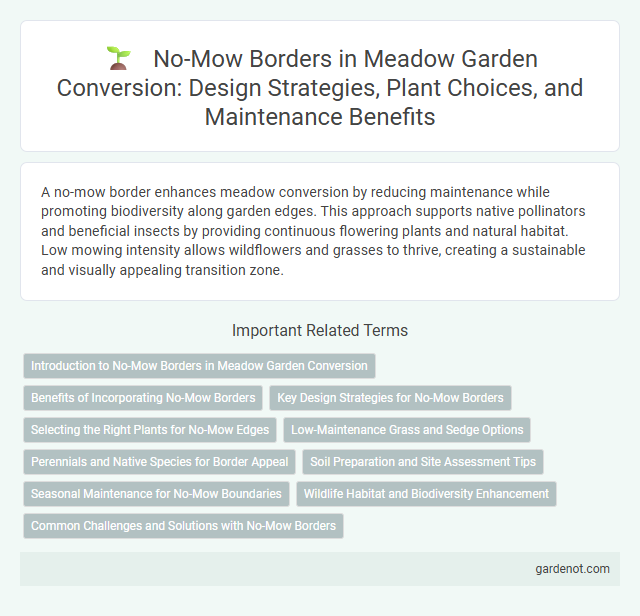A no-mow border enhances meadow conversion by reducing maintenance while promoting biodiversity along garden edges. This approach supports native pollinators and beneficial insects by providing continuous flowering plants and natural habitat. Low mowing intensity allows wildflowers and grasses to thrive, creating a sustainable and visually appealing transition zone.
Introduction to No-Mow Borders in Meadow Garden Conversion
No-mow borders in meadow garden conversion provide a low-maintenance, ecologically beneficial alternative to traditional lawns by supporting native plants and promoting biodiversity. These borders reduce soil erosion and improve pollinator habitats while enhancing garden aesthetics with natural textures and seasonal color variations. Implementing no-mow borders contributes to sustainable landscaping practices by minimizing the need for mowing equipment and chemical inputs.
Benefits of Incorporating No-Mow Borders
No-mow borders enhance biodiversity by providing essential habitats for pollinators such as bees and butterflies, supporting local ecosystems. These areas improve soil health and reduce maintenance costs by minimizing the need for mowing and chemical inputs. Incorporating no-mow borders also promotes water conservation through increased soil retention and natural filtration.
Key Design Strategies for No-Mow Borders
No-mow borders enhance meadow conversion by reducing maintenance and promoting native plant diversity through strategic plant selection and spacing. Incorporating drought-tolerant perennials and deep-rooted grasses improves soil health and supports pollinators while minimizing water usage. Designing layered plant heights and textures creates habitat complexity and visual interest, contributing to sustainable and low-maintenance landscapes.
Selecting the Right Plants for No-Mow Edges
Selecting the right plants for no-mow borders enhances biodiversity and reduces maintenance efforts. Native grasses, such as blue fescue and switchgrass, combined with low-growing wildflowers like creeping thyme and prairie dropseed, create an attractive, sustainable edge that supports pollinators and soil health. Choosing drought-tolerant, slow-spreading species ensures a durable, low-maintenance meadow transition that thrives in various soil conditions.
Low-Maintenance Grass and Sedge Options
No-mow borders featuring low-maintenance grasses like Festuca glauca and sesleria autumnalis create sustainable, drought-tolerant landscapes ideal for meadow conversions. Sedges such as Carex flacca and Carex oshimensis offer versatile groundcover that suppresses weeds and requires minimal watering. These plant choices enhance biodiversity while reducing mowing frequency and overall garden upkeep.
Perennials and Native Species for Border Appeal
No-mow borders featuring perennials and native species enhance meadow conversion by promoting biodiversity and reducing maintenance. Native plants like Echinacea, Rudbeckia, and Solidago provide seasonal color and support local pollinators, creating a sustainable, attractive landscape edge. These species thrive without mowing, fostering soil health and natural habitat connectivity along property lines.
Soil Preparation and Site Assessment Tips
Assess soil composition and drainage thoroughly before establishing a no-mow border to ensure optimal plant growth and root stability. Remove existing turf and weeds carefully, then till the soil to a depth of at least 6 inches to improve aeration and nutrient availability for native meadow species. Incorporate organic matter such as compost to enhance soil fertility and structure, promoting a sustainable, low-maintenance habitat that supports biodiversity.
Seasonal Maintenance for No-Mow Boundaries
Seasonal maintenance for no-mow borders involves targeted trimming during spring and fall to prevent invasive species and encourage native plant growth. Regular removal of dead plant material in late winter promotes healthy regrowth and enhances biodiversity. Monitoring soil moisture and adjusting watering practices ensures optimal conditions for perennial wildflowers within no-mow boundaries.
Wildlife Habitat and Biodiversity Enhancement
No-mow borders create essential wildlife habitats by providing diverse plant species that support pollinators, birds, and small mammals, enhancing local biodiversity. These areas act as natural corridors, facilitating species movement and genetic exchange while reducing habitat fragmentation. By allowing native flora to flourish, no-mow borders improve ecosystem resilience and support long-term environmental sustainability.
Common Challenges and Solutions with No-Mow Borders
No-mow borders often face challenges such as weed invasion, inconsistent growth, and boundary disputes with adjacent lawn areas. Effective solutions include regular selective weeding, using native plant species to promote dense growth, and installing physical barriers or edging to clearly delineate the no-mow zone. Proper soil preparation and periodic monitoring also improve plant health and reduce maintenance conflicts.
No-mow border Infographic

 gardenot.com
gardenot.com